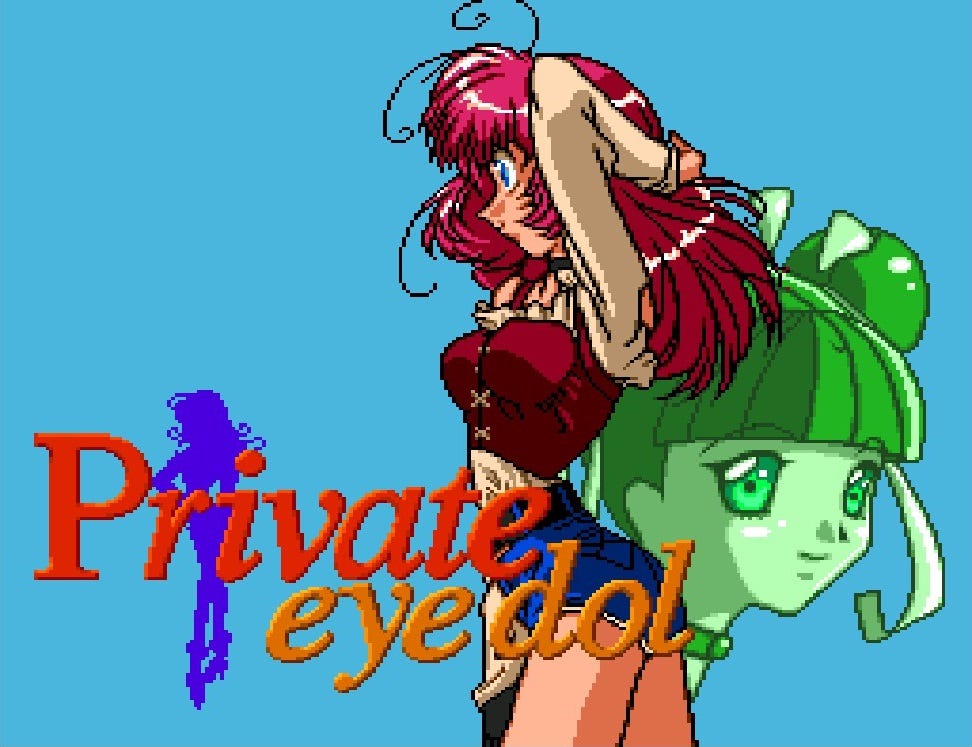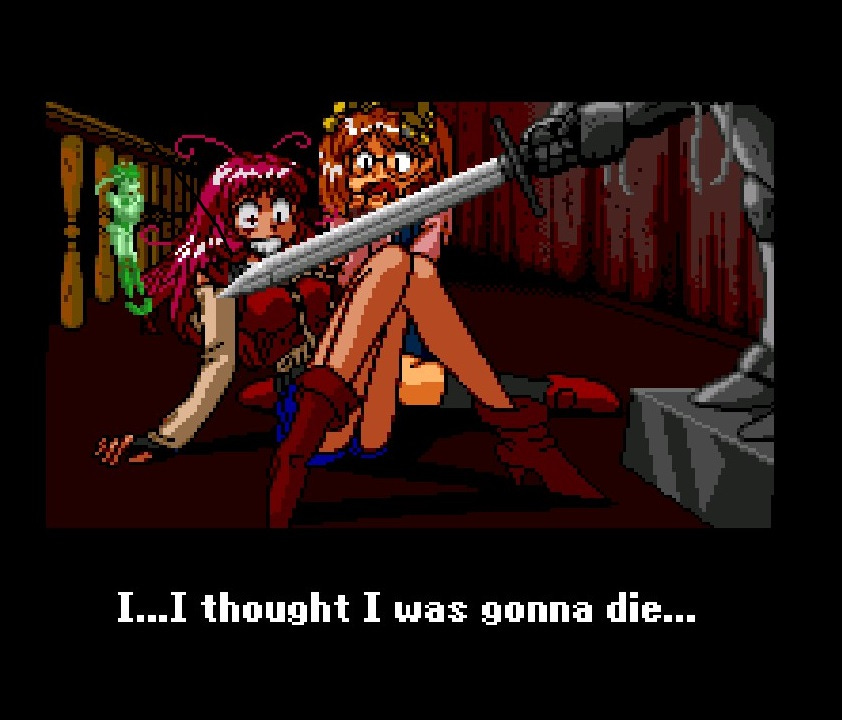Re-release this: Private Eye Dol
A Japan-only adventure game from 1995, one that should get another chance in the present during that genre's renaissance.
This column is “Re-release this,” which will focus on games that aren’t easily available, or even available at all, but should be once again. Previous entries in this series can be found through this link.
By the end of the summer of 1995, both the Sega Saturn and Sony Playstation had arrived in Japan and North America. The 3DO had already been on the market in the latter for a couple of years, too, and the Nintendo 64 was less than a year away from both regions. Video games were well and truly in the 32-bit (and beyond) era at this point, but the 16-bit systems still had plenty of life left in them, to varying degrees.
The PC Engine, which had first released in 1987 in Japan, was nearing the end of its lifecycle, and its successor, the PC-FX, had already come out in 1994. The original wasn’t finished yet, though, thanks to the various add-ons that helped push beyond the initial hardware boundaries of the system. Which is why, in 1995, an adventure game with cutscenes — some of them animated — voice acting, loads of huge character portraits, and detailed sprites was released for the PC Engine. It didn’t run on the base hardware: Private Eye Dol was a PC Engine Super CD-ROM² title, meaning, it was made for the second variant of the CD-ROM tech of the PC Engine, which had jumped the buffer RAM from 64KB to 256KB. Meaning, it could store more data at a time, cutting down on load times and frequencies, and the existence of this extra memory allowed for more complicated and larger games to be made for the PC Engine, which, again: it released in 1987, with specs that were cutting edge for a blip in time.
Private Eye Dol was a Super CD-ROM², yes, which was the standard for CD games on the Turbografx and PC Engine, but it was also one of a small group of titles — a baker’s dozen of games — that was enhanced by the addition of the Arcade CD-ROM², which, like the PC-FX, also landed in 1994. Unlike the Super variant, which was eventually built right into PC Engine (and Turbografx) hardware, the Arcade add-on was always just that. It came in two forms: one for older systems that didn’t have built-in Super CD-ROM² capabilities, the Arcade Card Pro, and one for the systems that did already have that hardware as part of its base, the Arcade Card Duo. This is all a little confusing, yes, but NEC, the manufacturer of the PC Engine family of systems, was trying to keep their 16-bit box relevant. While the sales weren’t there for Arcade titles, and support was low, the format did allow for some visually impressive titles, like Ginga Fukei Densetsu Sapphire, which used pre-rendered 3D graphics (and other graphical tricks) in such a convincing fashion that they seemed like real-time polygons. And we can at least appreciate all of that in the present.

As said, the extra RAM from these add-ons cut down on load times — the Arcade format added another 16 Megabits — which is no small thing for a CD-based system, since Red Book audio, if it were used for sound and music, would cut out during loading — the slower the load times, the more difficult it was to hide that there was loading at all, and if games had to load more often, that didn’t help matters, either. So, some games, like Private Eye Dol, were made for the Super CD-ROM², but if you happened to have an Arcade card, they’d run faster. In fact, you even got NEC’s Arcade logo right there on the artwork that appears during loading screens in the game:
Loading times aren’t the end all, be all, no, but consider that this was all a technological push happening at the time cartridges already just, you know. Worked. And fast. So being able to cut down on load times, and better utilize all of that information on the CD-ROMs, was a positive. That the existence of all of this extra RAM to support the PC Engine’s aged hardware allowed for games to not just run faster, but be more impressive, bigger, and so on — The Legend of Heroes got a whole second soundtrack because it ran on a CD-ROM, lots of games added voice acting and cutscenes, and all at a time when Final Fantasy IV had 16-bit sprites that didn’t look much different from their 8-bit predecessors smacking into each other on the game’s map during story bits, leaving the details of what those movements actually were to your imagination.
Private Eye Dol might seem like it was an obvious fit for the Playstation or Saturn instead of the PC Engine’s CD-ROM and Arcade formats, but that’s only true in a vacuum. The game was developed by HuneX, one of the parent companies of which was NEC Home Electronics, the makers of the PC Engine. HuneX was formed as a collaboration between NEC and Human — you might know them from Fire Pro Wrestling, as well as that place where Goichi Suda used to work. NEC (save for a brief return) left the video game space after its post-PC Engine failures, while Human went bankrupt in 2000. HuneX, though, continues on to this day. They’ve even released a couple dozen titles for the Nintendo Switch, and are active in PC development, as well.
HuneX is known mostly for their interactive romances, of both the Bishōjo and Otome variety. You can see quite a bit of that DNA in Private Eye Dol, which, while it’s an adventure game, is also very much centered around interacting with a lot of attractive folks, especially women. It’s not a game about romance, though, but instead about a dead father and a string of murders. That being said, the attention to detail in just how many portraits of all of these characters were drawn, as well as the detail within them, certainly foreshadows HuneX’s run as an interactive romance developer. Here, you play as May Star, a teenage actress whose (now deceased) father was a detective, right as she’s about to get a reason to pick up where he left off, both figuratively and literally. While the first murder happens before a shoot — the filming kind — and has more to do with the world May already exists in, the others are all tied into her father’s past, and therefore her future.

Private Eye Dol — now that you know that May’s an actress, you’ve noticed how hitting-you-in-the-head the game’s punned title is — takes a few different forms. There are a ton of cutscenes, both static and animated, there’s voice acting, there are huge character portraits that show up when characters are speaking outside of those moments. You navigate through the game’s world in a few different ways, depending on the chapter you’re in: sometimes it’s all on foot, and sometimes you also have to maneuver around the game world with a map, or through a menu that chains locations together, with you only able to access C from A by going through B. It all keeps things fresh in a way, and plays well off the scale of things. The first act takes place in a mansion, while the second begins on a passenger ship. You don’t need the menus or a map here, as it’s just a (admittedly large) house, and then a small cruise ship. When the ship drops you off on an island, though, then it’s time for a map in order to navigate. A map you have to fill in the destinations for yourself, through learning about where things are on the island by way of conversation with its inhabitants and visitors. If you place the temple in the woods in the wrong place, for instance, then when you arrive there, you’ll actually just be in a stretch of woods with nothing in it, and have to adjust your map to try again. The city is built in a much different way from a tourist island that lacks paved roads and such, so there you can just get by navigating from street to street, section to section, via menus.
In all of these acts, regardless of navigation methods, you’ll spend time on foot: this isn’t an adventure game like Ace Attorney, where you move from location to location to look at static backgrounds and then pick clues out from them. No, it’s closer to the model in Ace Attorney’s spin-off, Investigations: Miles Edgeworth, where you actually walk around, controlling a sprite, and interact with the environment that way instead of via point-and-click. One thing you’ll notice in a hurry here, is that the other characters all react to your behaviors. So, whereas Ace Attorney will outright tell you that character X left after a conversation, or that something in the room changed, in Private Eye Dol, you’ll actually see it happen. You’ll see the character walking away, to their next destination, which in some cases might be a clue as to where you want to go next, or might just be to let you know that the interaction is over, and it’s time to find the next one. Seeing a character show up in a room they weren’t in before when you were walking around is a sign you should go see if anything is different with them, if they have anything new to say or reveal. You’ll also notice more subtle changes in the environment by looking around, like a dart on the floor that wasn’t there before, or something stuck under a couch that you’ll want to check out. The end result is the same as if you were revisiting a static screen and doing the point-and-click thing, but it all feels a little more alive this way, and lets you more actively explore the environment.
You’ll have a variety of partners for your detective work. Motoko sees you as a rival in the acting industry at first, so you don’t get along so well, but from the end of the first act on, she’s your best bud, and right there to help you. Unless she’s off elsewhere, still helping, but just not alongside you. A detective who used to work with your father sometimes accompanies you as he realizes what’s going on in the cases you’re unofficially working. You always have your holographic assistant, Navi, at your disposal. Yes, Navi, a small fairy-looking creature who pops out to give you advice and direction when you need it. What? Nothing says Nintendo had to be the first to utilize “navigation” wordplay for a character name.
Private Eye Dol is constantly tweaking the gameplay in little ways, beyond just navigation. You don’t have the same mechanics for every case you’re trying to solve. There’s a ton of environment manipulation in the first act, but in the second, you’re on a ship with rules and regulations, and you can’t just go wherever you want, including into the rooms of other passengers. So you have to dig for information in limited spaces, and then build your investigation around the act of identifying various potential culprits, which you’ll do in the command menu: once you’ve selected a possible suspect, the dialogue with that person will change until you select a different one. With one very large exception, there isn’t much in the way of failure states. Just the game telling you that May maybe isn’t very smart or as good at this job as her father was. Which, to be clear, is a dig at you more than her. That exception, by the way, is in the final “showdown” with the person behind most of the death and destruction you’ve witnessed during the game. Luckily, you can save at any time, so just do that before this very obvious confrontation, and you’ll get to try again without repeating too much of the game.
There’s quite a bit of backtracking in Private Eye Dol, but you knew that once you saw that it was an adventure game from 1995. There are some moments where it might be unclear just what you need to do next, but do the thing you should always do in this kind of game in this kind of situation: go somewhere you’ve already been, and see if anything has changed. Is someone new in the window of the cafe? Is there something on the table that wasn’t there before? Do those puzzle pieces have something on the back that’s more obvious once you start flipping them over on purpose en masse? Need a key? Ask everyone about the key again, as the context of the word might have changed from the last time you did it, once you discovered some previous information that pushed the investigation further.
Private Eye Dol isn’t exceptionally lengthy by any means, but it’s not short, either — you’ll probably spend 10-12 hours on it, with the first act not taking all that long, but the second coming in two distinct parts, and the third similarly lengthy, albeit in one large location instead of two smaller ones. There is more Private Eye Dol out there, but not in video game form: there was a three-episode OVA released to help promote the game, featuring original stories and not just adaptations of the ones in the game, which unofficial translator @bowloflentils uploaded to the Internet Archive after recording emulated footage of the magazine. As they pointed out, the OVA originally came out via NEC’s PC-FX digital magazine — Anime Freaks FX — and was directed by Mitsuo Fukuda, who would go on to direct Mobile Suit Gundam SEED in 2002.
Given all of this effort — releasing the game for their largest possible audience by putting it on a Super CD-ROM² system instead of the PC-FX, ensuring it had Arcade Card enhancement compatibility, creating an OVA to promote it — it’s somewhat surprising NEC didn’t end up putting the game on other CD-ROM hardware afterward. The Saturn and Playstation were there, and the era of the PC Engine came to an end at 1994’s conclusion, anyway — games were still made for the system, but the console itself was discontinued. That’s not how things worked out, but maybe things can be different here in the future. Classic adventure games have seen a revival in terms of re-releases, remasters, or brand new outings, and there’s no real reason that Private Eye Dol shouldn’t get a turn, too. It’s still a lot of fun to play in the present, and it’s lovely to look at, thanks to all of the attention put into the graphics, design, and portraiture. There’s no English voice acting, no, but that’s only a barrier if a publisher wants it to be. There’s also already the unofficial translation, which could be used as the basis for an official English script, like with some of the recent international releases of older Trails titles.
And if not? Well, you can always emulate this game that’s otherwise not in English, and not available anywhere but secondhand. Good luck finding it there, though, since it averages one sale per year, and the hardware you use to play it isn’t exactly waiting around to be picked up at any retro game store you walk into. HuneX is still around, NEC can’t be that finicky about the rights at this stage: let’s make a re-release happen, so more people can enjoy this little gem that’s packed with character and charm.
This newsletter is free for anyone to read, but if you’d like to support my ability to continue writing, you can become a Patreon supporter, or donate to my Ko-fi to fund future game coverage at Retro XP.








I enjoy these deep dives. I know very little about the history of consoles before the late Nineties.